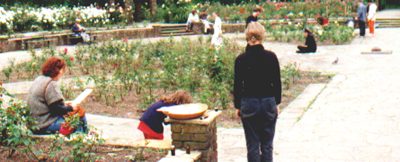
The Living Creature performance during the InterAction performance festival, The Rosegarden, Southwark Park, London, U.K. Foreground to Background: Sarah Buist (in black), Geeske Harting (seated on path), Sonja van Kerkhoff (in white) and Wim van Egmond (seated behind Sonja). |
EMCO, a London-based performance artist, had the idea to create a festival of performance as part of the annual Bermondsey Carnival in Southwark Park, London, U.K., and invited me to participate.
It evolved into a series of performances and installations by 25 European-based artists in and around the park and the Cafe Gallery over a five-day period in May 1999. I decided to invite a number of others to work with me because I was interested in creating a sense of 'community' through performance, rather than an act made by one individual. | ||||||||||||||||||||||||||||||||||||||||||||||||||||||||||||||||||||||||||||||||||||||||||||||||||
|
Two one hour performances on May 31st 1999: Sarah Buist, Geeske Harting, Wim van Egmond, Sonja van Kerkhoff, Jessy Rahman, Joke van Stuijvenberg, & Jacqueline Wassen. >> More info about the artists. |
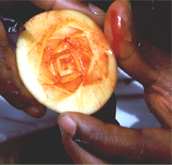
|
As people entered the semi-circular rose garden from one side, Jessy invited them to sit and eat a mango. If they agreed to this, he supplied them with utensils and while chatting he asked them about where they thought the mango came from, leading onto other questions and comments on 'roots' and sources for things. |
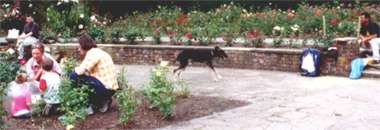 Left to Right: Tama McGlinn-van Kerkhoff (inside the ball), Wim van Egmond (seated in background), and Jessy Rahman seated on the left. | |||||||||||||||||||||||||||||||||||||||||||||||||||||||||||||||||||||||||||||||||||||||||||||||||
  
| |||||||||||||||||||||||||||||||||||||||||||||||||||||||||||||||||||||||||||||||||||||||||||||||||||
|
He was feeding them an exotic fruit, in a sense an extension of himself as a Surinamese living in Europe, but at the same time inviting them to reflect in a playful way on cultural difference. He then dried the pips and stamped them with a rose stencil and hung these in a line along the fence leading to the other side. | |||||||||||||||||||||||||||||||||||||||||||||||||||||||||||||||||||||||||||||||||||||||||||||||||||
|
If people entered the garden from the other side, Sarah greeted them and asked them to read a poem about taking risks. She then asked them some direct questions to get them talking about this subject and finally asked them to write a word down on a piece of paper. |
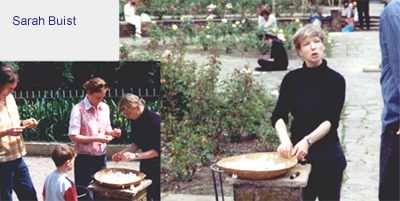
| ||||||||||||||||||||||||||||||||||||||||||||||||||||||||||||||||||||||||||||||||||||||||||||||||||
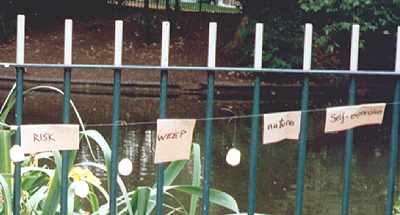
Detail of Sarah Buist's work. |
They were then invited to hang this word
on the fence. In between each word she hung a 'seed' on a string. The seeds were plaster-of-paris
covered walnuts. So reminders of interaction (with Jessy and Sarah) gradually extended inwards from each end of the fence by the pond. Wim had taken some water out of this pond and had put it under a microscope as part of his promotion of 'the less than one millimetre world'. | ||||||||||||||||||||||||||||||||||||||||||||||||||||||||||||||||||||||||||||||||||||||||||||||||||
|
His approach was educational. He showed people how to look through a microscope and the living world they became aware of did the rest.
Jacqueline set up shop a little further in the circular path from Wim. She opened her suitcase and took out her art-making tools and proceeded to paint, draw and write using the rose garden as her subject matter, inspiration and studio. If people came by she talked with them, and in this way her studio was interactive because it was more than just 'plein air'. |
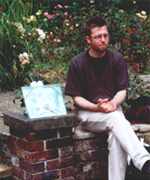
Wim van Egmond |
|
Her gesture of extreme 'non-interaction' in focussing on a thorn and then leaving that on loose sheets for the public to puzzle over, generated discussion around it.
People found this circle of thorns disturbing amidst all the colourful roses, and unlike the other works in our performance, there was no living person associated with this piece. The visitors were forced to make their own interpretations of the circle of pencilled thorns. It was a very well thought-out piece, out of necessity, and it made an impact on people who didn't know who that 'alone-in-her-studio/body' artist was. Its subject matter and location, at the point where the paths meet, and not the in-the-body artist, stimulated interaction with the visitors. |
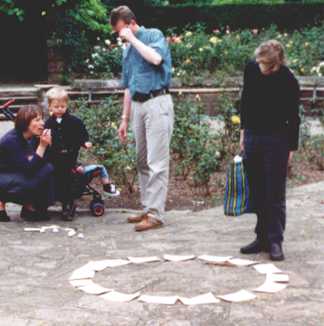
L to R: Works by Sonja van Kerkhoff (The Seeds of Hope) and Geeske Harting. | ||||||||||||||||||||||||||||||||||||||||||||||||||||||||||||||||||||||||||||||||||||||||||||||||||

Joke van Stuijvenberg and Tama. |
In contrast, Joke's plaster-of-paris dress moulded to the contours of her body, was the site for interaction with the public. People were asked to write a memorable colour in black ink on the dress and so the white of the dress gradually became blackened with words of colour.
For most visitors her work was the most visually stimulating. She was a walking work of art. I often use my children in my art but here Tama had his own ideas about what he wanted to do. All I did was place a large transparent ball between some rose bushes and help him to get into it. He did the rest. | ||||||||||||||||||||||||||||||||||||||||||||||||||||||||||||||||||||||||||||||||||||||||||||||||||
| For my part of this performance I wanted to make something that related to each of the other artists in our group. |
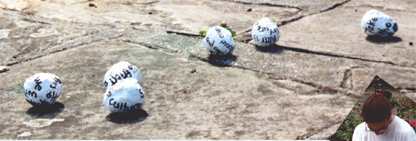 |
||||||||||||||||||||||||||||||||||||||||||||||||||||||||||||||||||||||||||||||||||||||||||||||||||
|
In the days leading up to this we had each shown each other our work and talked about it as well as sharing ideas on the function of performance work. For my piece, 'Seeds of Hope', I took about 50 of Sarah's 'seeds' and wrote unfinished sentences on them. I laid them in lines near each of the other artists according to a particular theme in response to that artist's work, as I interpreted it. |
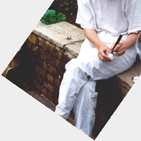 | ||||||||||||||||||||||||||||||||||||||||||||||||||||||||||||||||||||||||||||||||||||||||||||||||||
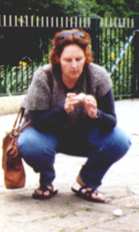
Someone reading the 'Seeds of Hope' near Tama's ball. |
These were: the unseen world (Wim), materiality (Jessy), risk (Sarah), the world beyond (Jacqueline), memory (Joke), individuality (Geeske), and category (Tama). Near each collection there was an instruction:
| ||||||||||||||||||||||||||||||||||||||||||||||||||||||||||||||||||||||||||||||||||||||||||||||||||
|
Some sentences were almost instructional such as; The material is a half-truth because or In the rose garden of your heart plant only the rose of Other texts were more reflective such as; Some say attitude prevail. To me attitudes always or A living creature responds actively to or We need to include the Other within the boundary of selfhood in order to or We all bring our differing histories into the garden and this... |

| ||||||||||||||||||||||||||||||||||||||||||||||||||||||||||||||||||||||||||||||||||||||||||||||||||
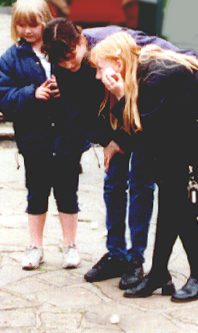
|
A wide variety of people entered 'our garden' from artists to carnivalgoers to park walkers, and most stopped to see what was happening and quite a few then proceeded around the garden to interact with the various aspects of the "living creature". | ||||||||||||||||||||||||||||||||||||||||||||||||||||||||||||||||||||||||||||||||||||||||||||||||||